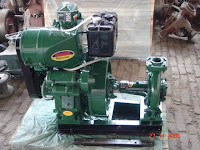Modern Plant breeding
Plant breeding is the art and science of changing the genetics of plants for the benefit of mankind. Plant breeding can be accomplished through many different techniques ranging from simply selecting plants with desirable characteristics for propagation, to more complex molecular techniques (see cultigen and cultivar).
 Plant breeding has been practiced for thousands of years, since near the beginning of human civilization. It is now practiced worldwide by individuals such as gardeners and farmers, or by professional plant breeders employed by organizations such as government institutions, universities, crop-specific industry associations or research centers.
Plant breeding has been practiced for thousands of years, since near the beginning of human civilization. It is now practiced worldwide by individuals such as gardeners and farmers, or by professional plant breeders employed by organizations such as government institutions, universities, crop-specific industry associations or research centers.International development agencies believe that breeding of new crops is important for ensuring food security by developing new varieties that are higher-yielding, resistant to pests and diseases, drought-resistant or regionally adapted to different environments and growing conditions.
Steps of Plant Breeding
The following are the major steps of plant breeding;
- Creation of variation
- Selection
- Evaluation
- Release
- Multiplication
- Distribution of the new variety
Modern Plant Breeding
There are generally three types on plant breeding in this modern age. They are given below:
Marker assisted selection
Sometimes many different genes can influence a desirable trait in plant breeding. The use of tools such as molecular markers or DNA finger printing can map thousands of genes. This allows plant breeders to screen large populations of plants for those that possess the trait of interest. The screening is based on the presence or absence of a certain gene as determined by laboratory procedures, rather than on the visual identification of the expressed trait in the plant.
Reverse Breeding and Doubled Haploids (DH)
A method for efficiently producing homozygous plants from a heterozygous starting plant, which has all desirable traits. This starting plant is induced to produce doubled haploid from haploid cells, and later on creating homozygous/doubled haploid plants from those cells. While in natural offspring genetic recombination occurs and traits can be unlinked from each other, in doubled haploid cells and in the resulting DH plants recombination is no longer an issue. There, a recombination between two corresponding chromosomes does not lead to un-linkage of alleles or traits, since it just leads to recombination with its identical copy. Thus, traits on one chromosome stay linked. Selecting those offspring having the desired set of chromosomes and crossing them will result in a final F1 hybrid plant, having exactly the same set of chromosomes, genes and traits as the starting hybrid plant. The homozygous parental lines can reconstitute the original heterozygous plant by crossing, if desired even in a large quantity. An individual heterozygous plant can be converted into a heterozygous variety (F1 hybrid) without the necessity of vegetative propagation but as the result of the cross of two homozygous/doubled haploid lines derived from the originally selected plant.
Genetic modification
Genetic modification of plants is achieved by adding a specific gene or genes to a plant, or by knocking down a gene with RNAi, to produce a desirable phenotype. The plants resulting from adding a gene are often referred to as transgenic plants. If for genetic modification genes of the species or of a crossable plant are used under control of their native promoter, then they are called cisgenic plants. Genetic modification can produce a plant with the desired trait or traits faster than classical breeding because the majority of the plant's genome is not altered.
To genetically modify a plant, a genetic construct must be designed so that the gene to be added or removed will be expressed by the plant. To do this, a promoter to drive transcription and a termination sequence to stop transcription of the new gene, and the gene or genes of interest must be introduced to the plant. A marker for the selection of transformed plants is also included. In the laboratory, antibiotic resistance is a commonly used marker: Plants that have been successfully transformed will grow on media containing antibiotics; plants that have not been transformed will die. In some instances markers for selection are removed by back crossing with the parent plant prior to commercial release.
The construct can be inserted in the plant genome by genetic recombination using the bacteria Agrobacterium tumefaciens or A. rhizogenes, or by direct methods like the gene gun or micro injection. Using plant viruses to insert genetic constructs into plants is also a possibility, but the technique is limited by the host range of the virus. For example, Cauliflower mosaic virus (CaMV) only infects cauliflower and related species. Another limitation of viral vectors is that the virus is not usually passed on the progeny, so every plant has to be inoculated.
The majority of commercially released transgenic plants are currently limited to plants that have introduced resistance to insect pests and herbicides. Insect resistance is achieved through incorporation of a gene from Bacillus thuringiensis (Bt) that encodes a protein that is toxic to some insects. For example, the cotton bollworm, a common cotton pest, feeds on Bt cotton it will ingest the toxin and die. Herbicides usually work by binding to certain plant enzymes and inhibiting their action. The enzymes that the herbicide inhibits are known as the herbicides target site. Herbicide resistance can be engineered into crops by expressing a version of target site protein that is not inhibited by the herbicide. This is the method used to produce glyphosate resistant crop plants (See Glyphosate)
Genetic modification of plants that can produce pharmaceuticals (and industrial chemicals), sometimes called pharmacrops, is a rather radical new area of plant breeding.








